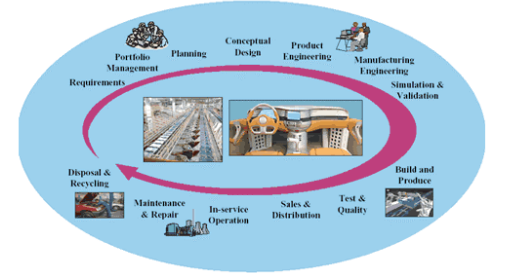
The way
product lifecycle management (PLM) is being used and implemented is changing. Reflecting the ever greater need for increased collaboration between departments, organisations are looking for PLM systems that are for more than just sharing data during the design and product development changes. According to a report on
www.designnews.com,
PLM and product development needs to connect service professional with engineers, integrating the whole company together.
Traditional PLM and product development set-up
PLM has, in the past, focused on the design stage. It allowed for improved collaboration between engineers throughout this process. PLM has been invaluable for organisations wanting to reduce product development costs, decrease waste in the design stages and decrease the time for a product to be sales ready. But, after the design stage, collaboration through a PLM system would end. There would be no direct engagement with the service team and no convenient or consistent way to collate the valuable data they gained through interacting with the product’s end-user.
So, how are PLM systems changing?
Developments in PLM now look to decrease the gap between engineering and service parts of an organisation. This makes collaboration and data sharing more convenient and more sustainable. It will reduce reliance on meetings and manual feedback procedures because the PLM system will automatically feed data across departments. Extending the scope of PLM across an organisation increases serviceability and creates a more unified approach to product development.
Advantages to closing the loop between engineering and service
As accessing and sharing data becomes easier for organisations to mange, extending PLM systems beyond the product design stage is a beneficial development for all departments involved:
- Service professionals have easy access to product-centric data. They are better equipped to answer client queries at the sales stage and beyond, leading to improved consumer experience and more effective service calls.
- Engineers are able to access the data imputed by service professionals, which they have received from the end-user. Engineers are then better able to see how the product is performing with end-users and can gather data on any reoccurring usability issues. It becomes easier for them to locate patterns in product performance and find solutions, should any problems occur.
Not sure how to choose a PLM and product development solution for your organisation? Download our free guide, 10 steps to selecting PLM, today. The way product lifecycle management (PLM) is being used and implemented is changing. Reflecting the ever greater need for increased collaboration between departments, organisations are looking for PLM systems that are for more than just sharing data during the design and product development changes. According to a report on www.designnews.com, PLM and product development needs to connect service professional with engineers, integrating the whole company together.
The way product lifecycle management (PLM) is being used and implemented is changing. Reflecting the ever greater need for increased collaboration between departments, organisations are looking for PLM systems that are for more than just sharing data during the design and product development changes. According to a report on www.designnews.com, PLM and product development needs to connect service professional with engineers, integrating the whole company together.
